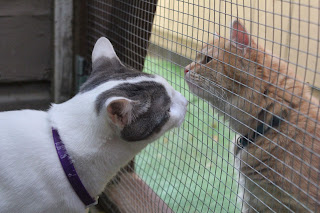 |
| Marley (left) was introduced to Curie when she was two yrs old and he was a tiny kitten. At first, she hated him... |
 |
| Introducing cats to children is similar to introducing a new cat |
Have you thought about adopting a new cat in celebration of "Adopt a Cat Month" this June? If so, you may be wondering how to best handle the introduction of the new cat into your household to make things go as smoothly as possible with your existing cats. If you've already read our blog article about
introducing your cat to a new baby, you probably already have some idea of how to introduce a new cat, but if you've never
done it before, you may want some suggestions.
1. Slow and steady - First of all, the best thing that you can do is NOT let the new cat out of the carrier right away. Place the carrier containing the new cat in the middle of the room and let your resident cats approach and investigate the new cat on their own terms. If they immediately seem curious, calm, and playful, you may be lucky enough to have cats that don't need a lengthy introduction. At this point, if the new cat is parasite-free and has been vaccinated and tested for diseases like Feline Leukemia and FIV, you can cautiously let the new cat out and observe face-to-face interactions. Be ready to step in and separate the cats if things get too tense.
It is ideal to have your new cat checked out by your veterinarian
before you bring them into your home, but this is not always feasible or
practical. If the new cat is not fully "vetted", you should not allow face-to-face contact until you have had the new cat checked out. You don't want to expose your resident cat to parasites or diseases. It is easier to treat one cat for ringworm, roundworms, fleas or ear mites than it is to treat your whole household. It is also not uncommon for a newly adopted cat to develop an upper respiratory infection shortly after adoption (no matter where they came from - breeder, shelter, stray, Craig's List...) because the stress of entering a new home can decrease the strength of the immune response. So, it may be prudent to keep your new cat separate for a few days, just to make sure he doesn't start sneezing.
 |
| Delilah and Roger, the two cats on the right, are brother and sister. They were successfully introduced to 6 year old Joey (left) as shy adults. Their owners had planned to board Joey with us while on vacation, so while he was at our hospital, we were able to introduce them all in a neutral environment. They have plenty of toys, cat trees and other valuable resources at home - enough to share, their owners used a lot of positive reinforcement during the introductory period, and it also helped that Roger and Delilah came from an environment with lots of cats living communally. The adjustment period was very short and Joey transitioned smoothly from being a single cat to being a "big brother". |
Otherwise, if your resident cat is hissing or growling or seems fearful, you should plan to keep the new cat separate for a while. Set up a spare room with food, water and litter and a cozy bed, and prepare to be patient. This room becomes a safe haven for the new cat, allowing him to establish a place that is "his" within the new home. This can help prevent future issues when he is introduced to the other cats in the home.
2. Scents-able suggestions - Your resident cat's biggest objection to the new cat is likely to be its smell. The new cat doesn't smell like your house - it smells like the rescue (hundreds of other cats!), the pet store (dogs!), or the outdoors (the scary unknown!). One way to accelerate the introduction process (if things are progressing smoothly) is to allow the new cat to sleep on some blankets or towels and then present these items to your resident cat. Once your new cat has spent a few days in the spare room (with plenty of visits for snuggles and pets to keep him from being lonely), switch the two cats. Put your resident cat in the spare room for a period to investigate the new smell in a non-threatening way. Let the new cat out and about in the house to allow him to explore and pick up more of the scent of the house. While he is out in the house, he will likely rub on furniture, play with toys and find a nice place to sleep. This will deposit some of his own scent in the house, meaning that the smell of the "colony" will smell more like him.
 |
| Encourage play under a closed door and reward positive behaviors with treats. Here, Mr. B is spending some quality time with Mona Lisa, while she is boarding. |
|
The addition of Feliway spray may help ease the transition, too. Feliway is a synthetic calming pheromone that will not only de-stress your cats, but will also help make them smell more similar. You can use the spray on individual items in the home, or place diffusers in both the room where the new cat is isolated, and in critical areas in the rest of the house where your cats spend most of their time.
Before you start to allow the cats visual socialization, feed the cats on either side of the door to the room where the new cat is staying. Cats are usually very food motivated, and being able to smell each other while enjoying a yummy treat will help them associate each other's smell with a positive experience. You can also encourage play underneath the door with feather toys or toys on strings that will encourage the cats to stick their paws underneath the door. Eventually, they may begin to play with each other in addition to the toys, with the door as a visual block to prevent aggression.
Once the new cat is starting to socialize with the other cats, reward any positive interaction or even calm non-interaction with treats.
3. Yours, mine and ours - Make sure that when your new cat comes out into the rest of the house, you adequately increase the number of litterboxes. There should be one more litterbox than the number of cats in the house, and ideally one box on every level in your home. For more about avoiding litterbox issues, please read our series of blog articles about
inappropriate elimination.
Each cat should have its own food bowl and place to sleep, at a minimum. Much of the stress in a multiple
 |
| To a cat, this is only one litterbox. |
cat household comes from competition for resources. A large number of food bowls, beds or litterboxes all in a row look like multiple resources to people, but to a cat, if they're all in the same location, they're all the same resource. Provide barriers between items to block cats' view of each other to decrease stress - for example, feeding one cat around a corner from the other.
4. Feline highways - Your new and resident cats may seem to be getting along well, without any fighting, but that may not mean that conflict is not there. We had a recent case where a cat in the home started urinating outside the litterbox after the introduction of another cat. Everything seemed quiet in the house, no fighting - the cats just avoided each other. However, after the owner went home and kept a close eye on the two cats, it became apparent that the new cat was blocking the resident cat from the litterbox. Every time he got up to go to the box, she would run up the stairs ahead of him, use the box, and then sit between him and the litterbox and just stare. Since there was only one box in the house, the poor fellow had no choice but to choose an alternative location to urinate! The addition of several more boxes in the house on different levels of the home made it so that there was no way for the new cat to block the resident's access to all litterboxes, and the problem resolved.
It is important that there be multiple access routes to all cat-related resources - food, water, litter, windows and beds - whatever your cat feels is most important. That may mean adding a new cat tree or two, some cat shelves on the walls, or putting out additional food and water bowls elsewhere in the house. Remember to "
think vertical" - your cat does! Adding some
elevated areas for your cat to climb or jump up to will increase the square footage of your cat's territory exponentially in your cat's eyes. Jackson Galaxy of "My Cat Fron Hell" on Animal Planet calls this process
"Catification".
 |
| "Catification" can be very subtle. |
It has been suggested that in order to minimize stress between cats in the same household, a minimum of 1.7m2 of floor space per cat is
necessary. This is equivalent to just over 18
square feet of floor space per cat. In a study of pairs of cats in homes, cats were
observed to keep a distance between themselves of 1–3 meters, suggesting
that cats housed together in the same room should be able maintain a respectful
distance from each other (roughly 3-10 feet) (horizontal OR vertical distance, that is). Even cats that are best friends will spend about 50% of their time out of each other's sight. (from:
The Welfare of Cats)
5. When your efforts fail - Depending on your cat, the introduction may take a few hours, a few days, weeks or months. As long as you are making slow progress, you haven't failed. The worst thing that you can do at this point is to become impatient and rush things. You can actually cause the problem to become worse if you do.
Key into your cats' signals. If either cat shows signs of stress or hostility at any stage of the introduction, stop and re-evaluate. Go back to a step in which all cats are calm and wait a few days to try again. You can extend each phase of the introduction by adding "baby steps". If cats are playing happily under the door, but opening the door causes hostility, you can prop the door slightly open with a door stopper, or set up baby gates, install a screen door, or use your imagination to make the introduction even more gradual.
 |
| Non-threatening socialization through a screen door |
Get your veterinarian involved. At Exclusively Cats Veterinary Hospital, our staff is well-versed in cat behavior and can offer specific recommendations that are tailored to your unique situation. In some cases, it may be necessary to add in a behavioral medication to aid the introduction. Some cats are hyper-aggressive or extremely shy and may need a course of anti-anxiety or calming medication in order to facilitate a good relationship. In some cases this medication may only need to be used for a short period, while other cases may need long term therapy.













